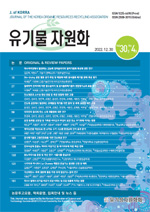학술논문
음식폐기물의 고형연료화를 위한 연소특성 연구
이용수 36
- 영문명
- A Study on Combustion Characteristics for Dry Food Waste
- 발행기관
- 유기성자원학회
- 저자명
- 상병찬 이승정 이도연 엄태인
- 간행물 정보
- 『유기물자원화』제30권 제4호, 101~108쪽, 전체 8쪽
- 주제분류
- 공학 > 환경공학
- 파일형태
- 발행일자
- 2022.12.31
4,000원
구매일시로부터 72시간 이내에 다운로드 가능합니다.
이 학술논문 정보는 (주)교보문고와 각 발행기관 사이에 저작물 이용 계약이 체결된 것으로, 교보문고를 통해 제공되고 있습니다.

국문 초록
본 연구는 유기성 폐기물 중 음식 폐기물의 고형연료제품으로서의 활용 가능성을 평가하기 위해 건조 음식폐기물의 물리화학적 성질 및 연소 특성을 분석하였다. 기존 고형연료와의 성상 차이를 비교함으로써 건조음식 폐기물의 연료로서의 특성을 분석 하였으며, 연료화 후 연소 특성을 파악하였다.음식 폐기물 시료 2종과 고형연료 제조설비로부터 생산된 고형연료 시료 2종을 이용하여 원소분석, 공업분석, 발열량분석, TGA 분석 실험을 진행 하였으며다음과 같은 결과를 얻었다. 건조 음식 폐기물의 수분함량과 회분함량은 각각 1.7~10.0 wt.%, 7.8~11.7 wt.%로 고형연료품질기준을 만족하였으며, 건조 음식 폐기물의 저위발열량은 4,000~4,720 kcal/kg으로 고형연료의 품질기준인 3,500 kcal/kg보다 높은 것으로 나타났다. 건조 음식 폐기물의 TGA 분석 결과, 연소반응은 약 200℃에서 시작하여 약 500℃에서연소 속도가 가장 높았다. 100~200℃ 사이에서 수분 증발 후, 200~500℃ 사이에서 초기 휘발분, 탄소 및 잔류 휘발분의방출 및 연소가 이루어졌다. 건조 음식 폐기물의 높은 발열량 및 낮은 수분, 회분 함량을 바탕으로 향후 효율적 건조기술 적용 및 엄격한 품질 기준 검사를 통해 건조 음식 폐기물의 고형연료화가 가능한 것으로 판단된다.
영문 초록
This study analyzed the physicochemical properties and combustion characteristics of dry food waste to evaluate the possibility of using food waste as a solid refuse fuel (SRF). The characteristics of dry food waste as a fuel were analyzed by comparing the difference in properties with SRF, and the combustion characteristics after conversion into fuel were identified. Ultimate analysis, proximate analysis, calorific value analysis, and TGA analysis were conducted using two types of food waste and two types of SRF, and the following results were obtained. The moisture content and ash content of dry food waste were 1.7~10.0 wt.% and 7.8~11.7 wt.%, respectively, which satisfied the quality standards for SRF. The low calorific value of dry food waste was 4,000 ~ 4,720 kcal/kg, which was higher than the quality standard of 3,500 kcal/kg for SRF. As a result of TGA analysis of dry food waste, the combustion reaction started at about 200 °C and the highest burning rate was at about 500 °C. After moisture evaporation between 100 and 200 °C, initial volatile matter, carbon and residual volatile matter were released and burned between 200 and 500 °C. Based on the high calorific value and low moisture and ash content of dry food waste, it is considered that it is possible to convert dry food waste into SRF through the application of efficient drying technology and strict quality standard inspection in the future.
목차
1. 서 론
2. 재료 및 방법
3. 결과 및 고찰
4. 결 론
사 사
References
해당간행물 수록 논문
- 이산화탄소-촉매 열분해 활용 우분 유래 합성가스 증대 연구
- 옥수수 밭에서 유기질 비료가 토양 비옥도 및 토양 호흡에 미치는 영향
- 토양 종류별 보릿짚 및 가축분 바이오차 투입이 토양 탄소 무기화에 미치는 영향
- Bio-drying 공법 활용 공기 투입 및 예열에 따른 음식물류 폐기물 분해 특성 평가
- 반도체 공정에서 발생하는 유해물질 제거를 위한 흡착 및 촉매 공정에 대한 고찰
- 분뇨처리시설 운영 및 개선 연구
- 탄소재료의 소수성 향상 방법 및 측정 방법에 대한 고찰
- 하수처리장에서 발생하는 고농축 잉여슬러지의 열적가용화 특성에 관한 연구
- 유기물자원화 제30권 제4호 목차
- 열화학적 전처리에 따른 탈수슬러지 및 음식물류폐기물의 병합혐기소화 효율 평가
- 니카라과 마나과시 La Chureca 매립장 온실가스 발생량 산정 및 예측
- 이차전지 음극재 탄소 소재 재활용에 대한 연구
- 제주도민을 대상으로 한 스마트 수거 시스템 환경교육 인식 효과 분석
- 음식폐기물의 고형연료화를 위한 연소특성 연구
- 반부숙상태 돈분뇨 액비의 저장기간 및 폭기여부에 따른 특성 변화
참고문헌
교보eBook 첫 방문을 환영 합니다!

신규가입 혜택 지급이 완료 되었습니다.
바로 사용 가능한 교보e캐시 1,000원 (유효기간 7일)
지금 바로 교보eBook의 다양한 콘텐츠를 이용해 보세요!






